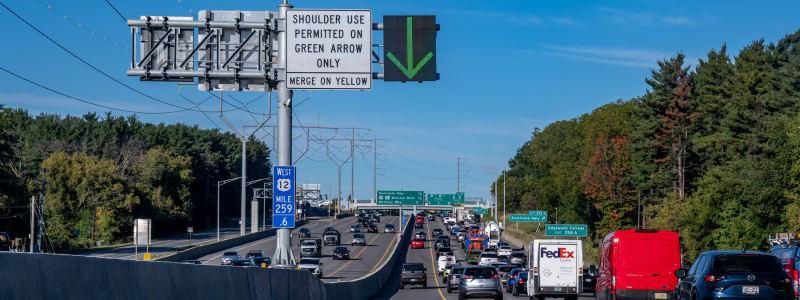Safety Increases While Travel Times Decreases: Wisconsin’s First Shoulder Running Lanes
 Written by Jerry Shadwald, PE; HTNB
Written by Jerry Shadwald, PE; HTNB
![]()
What if...
What if a shoulder running lane could improve safety (crashes decreased nearly 20%) while lowering travel times (up to 50% reduction in peak times)?
What if is the question Wisconsin Department of Transportation (WisDOT) answered when it seized the opportunity to use a new congestion management tool on the Madison Beltline.
Let’s look back.
When pavement conditions on the Beltline (originally constructed in 1949) required an asphalt overlay to extend its life, WisDOT identified that a small additional investment could potentially provide significant value. The existing Beltline corridor is Madison’s busiest roadway and regularly experienced congestion resulting in unreliable travel times and often unsafe conditions with high-speed vehicles approaching slow or stopped vehicles. Reconstruction of the Beltline and associated long-term modernization and capacity expansion options are being studied but are many years away due in part to both a need for a detailed environmental study along with extensive construction and right-of-way costs. Through coordination with Michigan DOT, WisDOT identified the use of a dynamic part-time shoulder use concept as an interim solution to address congestion with minimal safety or right-of-way impacts. WisDOT then set about to deliver the solution within the tight geometric constraints of Madison’s busiest roadway.
Branded the Flex Lanes, Wisconsin’s first shoulder running lanes utilize overhead dynamic signing to alert drivers when it is allowable to use the shoulder as an additional driving lane. This innovative solution comes at a significantly lower cost than a traditional capacity expansion.
Like most regionally significant projects, success required many entities partnering with WisDOT to achieve the goal. Dane County, the City of Madison and various other local and statewide agencies, including emergency responders partnered with WisDOT to implement the innovative Flex Lane project.
Several firsts were established during the design, implementation and operations phases, including:

- New application of Active Transportation Management System (ATMS) in Wisconsin, using dynamic lane control signs (LCS) to allow for shoulder lane use based on observed traffic conditions, typically around 3 hours for both the AM and PM weekday peak periods.
- New dynamic LCS (green arrow, yellow X and red X) based on new FHWA guidance were implemented at over 50 locations.
- New static signing (supplemental signing to instruct drivers on use during green arrow).
- New traffic control room software to process video and in-field vehicle detection data to monitor Beltline operations, recommend the dynamic opening or closing of the Flex Lane, and implement the operator’s actions to open or close the Flex Lane.
- New Flex Lane operators (WisDOT staff trained in the operation of the Flex Lane) and a new Flex Lane operator’s manual.
- New geometric concept of using a narrow 10-foot-wide Flex Lane and 11-foot general purpose lanes to retrofit existing roadway to include the Flex Lane and the original 3 directional lanes without additional right of way.
- New Flex Lane opening procedures in conjunction with Dane County sheriff and maintenance crews including both physical and virtual tours of the Flex Lane prior to opening.
- New concept of dynamically closing the Flex Lane during large rain events compared to adding additional multi-million-dollar drainage systems to eliminate water spread into the Flex Lane.
- New level of communication and coordination with emergency responders to allow for dynamic opening or closing of Flex Lane to aid in incident response.
- New ITS maintenance standards which require near immediate repair of critical dynamic lane control signing and 36 supporting cameras.
In its short time in use, WisDOT’s Beltline Flex Lane has effectively addressed both traffic congestion and the deteriorating infrastructure needs in a cost-effective manner. The Flex Lane can be opened or closed as needs dictate including to aid in incident response, to respond to adverse weather conditions or to accommodate special events or construction activities. It typically operates for approximately six hours each weekday, then serves as the median shoulder for the remaining 18 hours per weekday and both Saturday and Sunday.
 HNTB and Strand Associates collaborated with WisDOT to lead design and system implementation effort. The project was completed with minimal traffic disruptions, on time, with cost-savings and positive public reception. The project was awarded with the 2023 Engineering Excellence Grand Award.
HNTB and Strand Associates collaborated with WisDOT to lead design and system implementation effort. The project was completed with minimal traffic disruptions, on time, with cost-savings and positive public reception. The project was awarded with the 2023 Engineering Excellence Grand Award.
About the Guest Blogger
 Jerry Shadewald is a Project Manager in HNTB’s Madison office. His passion for travel demand modeling, traffic microsimulation, traffic operations analysis and corridor planning supports HNTB’s commitment to enhance mobility, opportunity and quality of life for everyone through responsive, innovative solutions and Making Connections Possible. Learn more about the Flex Lane here.
Jerry Shadewald is a Project Manager in HNTB’s Madison office. His passion for travel demand modeling, traffic microsimulation, traffic operations analysis and corridor planning supports HNTB’s commitment to enhance mobility, opportunity and quality of life for everyone through responsive, innovative solutions and Making Connections Possible. Learn more about the Flex Lane here.
